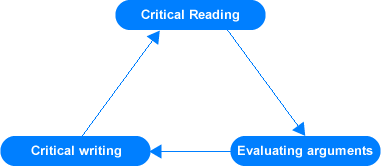Critical thinking, sometimes referred to as Higher Order Thinking (HOT), is a concept that is growing in popularity in higher education. There are various definitions and models of critical thinking (e.g. Bloom's taxonomy, De Bono's thinking hats), but a constant theme within them all is a "capacity to work with complex ideas whereby a person can make effective provision of evidence to justify a reasonable judgment" (Moon 2005).
It involves the ability to:
N.B. Critical in this context does not mean criticism in a negative way, but critical defined as: 'Involving or exercising careful judgment or observation' (OED Online 2013)
Being a critical thinker enables you to evaluate information and use it appropriately to develop, justify and communicate your own arguments. This type of thinking is expected within higher education and is key to getting a good mark in assessments. Beyond university it is a skill that employers seek and expect from graduates. From a learning perspective, critical thinking ensures that you fully participate in higher education study and enables deep rather than surface learning. This helps you to engage with your studies, facilitating greater enjoyment of the topics and the learning process. It is a key element of collaborative learning, where you are working with the lecturer to develop your knowledge of a subject, rather than expecting to be 'spoon fed' information.
Critical thinking is a process that is developed gradually over time and, like all skills, needs practice.
There three areas for development: critical reading; evaluating arguments; and critical writing. (Wilson 2009).

Critical reading involves evaluating the information that you find or are provided with. You need to discover and think about who wrote or produced it, when and why. This will help you to put the work into context, alert you to any potential bias and the reasons for this. Has the work been well researched? Is the bibliography made up of relevant, quality sources? Is the methodology for the research appropriate?
As you actively read through the work (remembering the purpose of your reading), evaluate the argument. Are the arguments backed up with strong evidence or are they just conjecture? Do the arguments make sense? If not, why not? Is the data used reliable? Remember that the same set of statistics can often be used in both positive and negative ways. Have different views to the author been taken into account or have they simply been ignored? Use your own growing knowledge of a topic to question and challenge the argument. Your confidence to do this will grow over time, as your knowledge deepens through your critical reading.
To demonstrate that you have been thinking critically, you then need to complete the cycle by writing critically. To do this you need to organise your own arguments logically, ensuring that you back up any assertions with appropriate evidence and demonstrating that you have taken other points of view into account. All evidence and points of views should be properly referenced in the appropriate citation style. The writing style should be even tempered and balanced –no dramatic, strong language or jargon. To check that you have been successful in your aim, don't forget to critically read your own writing!
Connect with the HIT Library